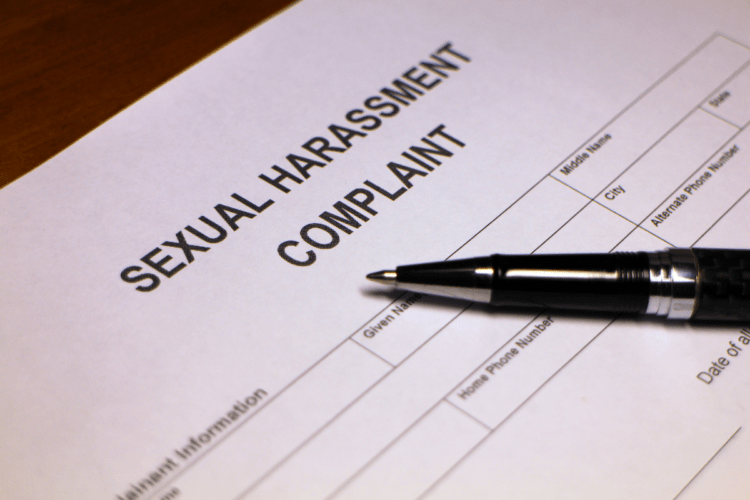9 Sexual Harassment at work myths you need to read

Here are 9 Sexual Harassment at work myths you need to read…
Myth 1: “Banter” is not sexual harassment
Fact: Employment lawyers will often hear as a defence to a sexual harassment claim that “it was only banter”.
Time and again tribunals have rejected the notion that a harassment claim can be defended on the basis that sexist remarks were “only banter”.
Key case: In Driskel v Peninsula Business Services, the Employment Appeal Tribunal (EAT) upheld a claim by a female manager that she had been discriminated against by her head of department when she was seeking a promotion.
Remarks from the head of department included that she should wear a short skirt and see-through blouse showing plenty of cleavage if she wanted to be successful during a promotion interview.
The claim was successful despite the head of department thinking that his comments were acceptable banter.
Myth 2: It is not sexual harassment if the victim does not complain
Fact: Employment tribunals recognise that the employee is normally in an unequal relationship with the harasser, and that it is a natural reaction not to wish to create further conflict.
A lack of action from the victim can often be attributed to a fear of losing employment.
Key case: In Munchkins Restaurant and another v Karmazyn and others, the EAT upheld a claim that a restaurant manager sexually harassed four waitresses.
This was despite the waitresses putting up with the manager’s conduct over a significant period of time, and even initiating talk of a sexual nature as a method of coping with and diffusing his behaviour.
Myth 3: A single comment that is not repeated cannot be sexual harassment
Fact: It is well established from case law that a single act can fall within the definition of unwanted conduct under the Equality Act 2010.
For example, no employment tribunal in the land would have any sympathy for a harasser who is dismissed after committing a one-off serious act of sexual misconduct, even if further harassment does not follow.
Key case: In Insitu Cleaning Co Ltd and another v Heads, the EAT upheld a tribunal’s finding that a woman had been sexually discriminated against when a manager said to her “hiya, big tits”.
The EAT held that the tribunal was entitled to conclude that the one incident was sufficiently serious to amount to sexual harassment.
Myth 4: A benign motive is a defence against a sexual harassment allegation
Fact: The motive of the “harasser” is irrelevant in sexual harassment claims. The key issue will be the effect on the person who is on the receiving end of the behaviour.
Key case: In Craddock v Fontoura t/a Countyclean, a business owner was found to have committed harassment after he repeatedly suggested that a male employee should form a relationship with a particular female colleague.
The employment tribunal found that the business owners attempts to “play cupid” between staff constituted sexual harassment, despite his apparently benign motive.
Myth 5: A compliment cannot be sexual harassment
Fact: It is sometimes commented that a man who compliments a woman on her appearance at work cannot be committing sexual harassment.
While an innocent remark between colleagues who know each other well is unlikely to constitute harassment, tribunals will look at the context in which a remark is made.
In many cases, comments about a woman’s appearance will be deemed to be inappropriate in the workplace.
Key case: In Urbanska-Kopowska v McIlroy and another t/a Mac’s Quality Foods, the tribunal awarded £65,000 to a Polish woman who was sexually harassed by another worker.
Allegations included that the worker said to her that “she was his type and he would eventually have her” and that she had a “nice bottom”.
Myth 6: Sexual harassment always involves a physical act
Fact: The definition of sexual harassment under the Equality Act is exceptionally wide.
For example, it could involve the display of pornographic material (such as pictures of naked women on a computer) or leering at a woman in a manner that is overtly sexual.
Key case: In Moonsar v Fiveways Express Transport Ltd, the EAT held that male employees viewing pornographic images on the internet in an office where a female colleague was present constituted sexual harassment.
Myth 7: An allegation of sexual harassment is considered only from the viewpoint of the victim
Fact: Tribunals will take into account how a complainant perceives the actions that have led to a harassment claim.
However, tribunals will also take into account whether or not it was reasonable for the conduct to have had the effect of violating dignity or creating an offensive environment.
An employer could have a defence if it thinks that an employee is being “over-sensitive”.
For example, overhearing a sexual swearword in a work environment where swearing is commonplace might not be considered sexual harassment.
Key case: In religious discrimination case Heafield v Times Newspaper Ltd, the EAT held that there was no harassment when an employee took offence at a colleague’s comment using an expletive when referring to the Pope.
In the context in which the remark was made, it could not reasonably be viewed as harassment.
Myth 8: A subordinate cannot sexually harass a manager
Fact: While sexual harassment often involves the abuse of power by a senior manager over an employee, there is nothing to stop an employee, or a group of employees, from being liable for harassing a manager.
For example, sexual harassment could occur where a female manager is managing mostly men in a male-dominated workplace.
Key case: In Fairbank v Royal Mail Group Ltd, the employment tribunal upheld a sexual harassment claim from the only female manager in a predominantly male environment.
The tribunal found that the male staff carried out a campaign of bullying the female manager, including one employee saying to her that “the only reason you have got this job is because you have tits and a fanny”.
Myth 9: Only the person towards whom the behaviour is directed can bring a sexual harassment claim
Fact: It is perfectly possible for someone to claim sexual harassment when the offending remark or action is not directed at that person.
For example, a woman who overhears a sexist remark could bring a sex discrimination case, even if the perpetrator does not realise that she is listening.
Key case: In Mrozinski v Q Medical Technologies Ltd, the employment tribunal had the unusual task of deciding whether or not a female employee was sexually harassed when she witnessed her male line manager and another man re-enacting a scene from the film Ghost at an office party.
While the tribunal found that this incident was not harassment, the employer was ordered to pay the claimant £2,000 for several other incidents that displayed her line manager’s “predilection for innuendo”.
Myth 10: Sexual harassment can be committed only by a man against a woman.
Fact: Sexual harassment is traditionally thought of as a man’s unwanted actions towards a woman. But there is nothing to stop a man claiming harassment against a woman, or an individual claiming to have been harassed by someone of the same sex.
Key case: In Basile v Royal College of General Practitioners and others, the employment tribunal held that a man discriminated against another man with sexual comments and gestures, not all of which were directed at the claimant.
These included the greeting “how’s it hanging?” and the witnessing of sexual hand gestures.
So, how to set the foundations…..
If you don’t have a Harassment Policy to issue to your employees as part of your Employee Handbook then you are leaving your business open to a huge risk – take a look at our Online HR toolkit and see how you can have this covered.
“Excellent Service”
“Reassuring to know that there is up-to-date HR advice readily available” Read the full review
The content of this article is for general information only. It is not, and should not be taken as, legal advice. If you require any further information in relation to this article please contact us.
There may be occasions where the articles contain links to external websites. We have no control over the nature, content and availability of those sites. The inclusion of such links does imply a recommendation or endorse the views expressed within them.



